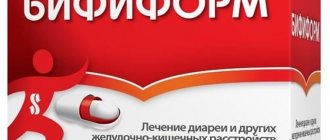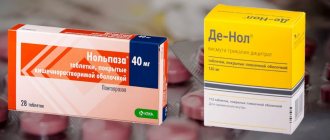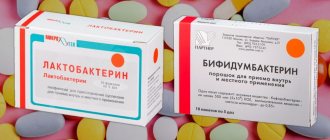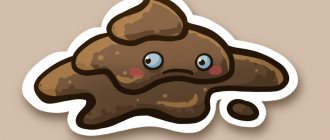Positive properties
When prebiotics enter the body, they provide food for beneficial bacteria . In the process of restoring the microbial biocenosis, these elements activate complex biochemical reactions that optimally maintain conditions for the development of microflora, supply bacteria with the necessary substrates (anti-stress peptides, amino acids, vitamins), and supply energy to “friendly” microorganisms. In addition, prebiotics in the intestinal lumen “acidify” the environment, resulting in unfavorable conditions for the development of harmful organisms.
Biological properties:
- Neutralizes the harmful effects of antibiotics on microflora.
- They increase the volume of feces and stimulate intestinal motility.
- Increase the activity of protective antibodies, stimulate cell immunity.
- Accelerate the restoration of the colon mucosa, preventing the appearance of colorectal diseases, including carcinoma and adenoma.
- Reduces the concentration of cortisol (stress hormone) in the blood.
- Strengthen the intestinal walls, reduce the permeability of the mucous membrane to the passage of food debris, toxins, and bacteria.
- Reduces bloating, reduces gas formation.
- Maintains normal acid-base balance in the intestinal tract.
- They “combine” and remove toxic substances, salts of heavy metals, bile acids, and toxins from the body.
- Suppresses the development and growth of pathogenic organisms (streptococci, staphylococci, campylobacter, yeast, vibrio cholerae).
- Improves the absorption of essential macroelements (magnesium, calcium, copper, zinc).
- Activate the synthesis of vitamins B and K.
- Reduce serum cholesterol.
- Stops the appearance of malignant tumors in the colon (at an early stage).
- Accelerate the release of mucus that has accumulated on the walls of the stomach.
- Do not allow gastric juice to reflux into the esophagus.
In addition, prebiotic cultures reduce appetite, which promotes weight loss .
The editors of the site advise reading the article about the benefits and indications for the use of succinic acid.
Food prebiotics
Inulin is a popular dietary supplement in this series at the moment. It is found in many vegetables and it is their consumption that is beneficial for our body. This prebiotic stimulates the growth of bifidobacteria, displaces pathogenic microflora, promotes the absorption of calcium and reduces the concentration of cholesterol in the blood, and has immunomodulator properties.
Dietary fibers are prebiotics; they belong to the group of polysaccharides. Among other things, dietary fiber is also an adsorbent; it removes toxins and various harmful substances from the body.
Food prebiotics include cellulose, which is found in grains, fruits and vegetables (citrus fruits, dried apricots, prunes, carrots, radishes, rutabaga, cabbage, parsley, dill, lingonberries, red currants, rose hips...). Cellulose also removes toxins from the body, making room for beneficial microflora. For the human body, there is a norm of about 30 g of cellulose per day.
Food prebiotics also include lactulose, which is found in lactic acid products and whole milk; it stimulates the growth of lactobacilli.
Pectins are beneficial for our intestines. They promote healing of the mucous membrane and have adsorbent properties. Pectins are found in ripe berries, fruits and vegetables, apples, plums, currants, beets...
Gums and mucilages are found in algae, plant seeds, fruits (barley grains, flax and plantain seeds, brown rice...).
Prebiotics in foods
Prebiotics are found in foods:
- Jerusalem artichoke; - wheat bran and flour; - chicory (root); - onion and garlic; - asparagus; - bananas; - dandelion stems and leaves; - oat bran and bran bread; - artichokes; - strawberry.
How are prebiotics different from probiotics?
The names of these two groups of funds are quite similar , which is why they are often confused:
- Prebiotics are chemical organic substances that have the ability to create good conditions for the development of normal intestinal microflora.
- Probiotics are live microorganisms that belong to the normal intestinal microflora.
It must be said that the effect of probiotics and prebiotics is similar, since each of the groups of these drugs normalizes the intestinal microflora.
Prebiotics without probiotics are useless
There is one important nuance. Prebiotics will enter the body and even “set the table” for beneficial microorganisms. But whether anyone will come to this table is a big question. If there is not enough beneficial microflora, if the delicate balance is disturbed, then “freeloaders” - pathogenic microorganisms - will attack the treat. Accordingly, the effect may be the opposite of what was expected.
Therefore, it is best if the dog eats food enriched not only with pre-biotics, but also with probiotics. However, there is a big problem with adding the latter to dry food. Almost all probiotic microorganisms are characterized by extreme vulnerability to environmental factors.
High or low temperatures, exposure to air, even storage time cause the complete death of microorganisms. And even if you add probiotics to dry food, they have practically no chance of reaching the dog’s intestines alive.
Kinds
Prebiotics are low molecular weight carbohydrates . Polymer molecules that are connected to each other by one or a series of beta-glycosidic bonds. Moreover, the simpler the saccharide, the faster it acquires pronounced bifidogenic properties and is fermented with the intestinal microflora.
Systematization of drugs by chain length:
- dimeric (the molecule contains 2 monomer units);
- monomeric (single-unit molecules);
- polymer (there are more than 10 units);
- oligomeric (the molecule contains 3-10 units).
Monomeric drugs have a bifidogenic effect already in the oral cavity and esophagus, polymeric drugs - along the entire length of the colon, oligomeric - in the upper parts of the large intestine, dimeric - in the small intestine and stomach. The combination of carbohydrates of different types of complexity for beneficial bacteria creates a balanced “feeding” .
If you use one series of prebiotics for a long time, then microorganisms become activated in a limited part of the gastrointestinal tract. Moreover, other strains of probiotics develop disproportionately. As a result, the positive effect of beneficial flora on the body is significantly reduced.
List of main representatives of prebiotics:
- inulin (a natural polysaccharide that is present in Asteraceae plants);
- lactulose (element of dairy products);
- soluble fiber (psyllium, pectins, chitosan, guar gum, psyllium seeds);
- breast milk oligosaccharides;
- antioxidants (selenium, carotenoids, ubiquinone, glutathione, vitamins E, A, C);
- fructooligosaccharides;
- food insoluble fibers (hemicellulose, cellulose, bran, lignin);
- sweeteners (raffinose, xylitol, sorbitol);
- galactooligosaccharides, including lactose;
- oligofructose (one of the components of inulin);
- microbial and plant extracts (carrot, potato, pumpkin, corn, yeast, garlic, rice);
- para-aminobenzoic acid;
- amino acids (glutamic acid, arginine, valine);
- polydextrose (a polysaccharide formed by glucose residues);
- unsaturated fatty acids;
- acacia resin;
- algae extracts;
- resistant starches;
- lectins (protein structures that are able to bind complex sugars);
- enzymes (bacterial beta-galactosidases, Saccharomyces proteases).
The compounds described above are found in natural prebiotics , and are also used as a selection list for biologically active complexes and medications.
Prebiotics: price and how to buy
There is one problem when buying these drugs: they are popular, the need for them is growing day by day, and today there are counterfeits. Before purchasing a prebiotic, make sure that you are not purchasing a counterfeit drug. To do this, find out the selling company and the manufacturing company. The seller must have the appropriate certificates for certain drugs.
It’s easy to buy prebiotics from us:
1. “Add” the drug to your cart and place an order on this website.
2. Call our manager and order the drug.
To buy good quality prebiotics, contact our specialists. At the same time, when choosing products, you should pay attention to the following points: • manufacturer. It is better to give preference to proven brands that have properly proven themselves during their existence on the market; • release form. It determines the ease of use of the product in question; • compliance with storage conditions. The effectiveness of the drug depends on this. These are the main points you should know when considering the topic and deciding to buy prebiotics. We have these drugs from the manufacturer, and the drugs are certified. Delivery of drugs throughout Russia and the CIS countries without delays and in the shortest possible time.
The price of prebiotics is on the page corresponding to the drug. You will receive a free consultation on any drug from our managers - specialists in the field of prevention and human health.
Food sources
To maintain a healthy gut flora, include food sources of prebiotics in your daily diet. The minimum daily dose is 20-30 g. (of which lactulose invariably accounts for 5 grams, and pure inulin – 7 grams).
Choosing foods that contain prebiotics:
- chicory root;
- Jerusalem artichoke;
- figs;
- asparagus;
- onion;
- bananas;
- dairy products with lactulose;
- sauerkraut;
- garlic;
- beans;
- cabbage;
- cereals;
- rose hip;
- fruits, citrus fruits including;
- corn;
- swede;
- turnip;
- dandelion leaves;
- cowberry;
- Red currants;
- artichoke;
- dried fruits (dried apricots, prunes).
Monocomponent probiotics
Mono-component products contain one type of beneficial bacteria.
Representatives of monocomponent probiotics:
1. Bifido-containing preparations, which include bifidobacterium bifidum
- Bifidumbacterin
- Bifidumbacterin forte and Probiofor (bifidobacterium bifidum, sorbed on activated carbon) - this form should theoretically be more active than the usual one, but there is no clinical evidence of this. It should be noted that the number of bacteria in Probiofor is 10 times higher than in Bifidumbacterin forte
- Bifinorm
Probiofor contains 500 million CFU Bifidumbacterin forte contains 50 million CFU
Probiotics of this group are available in the form of dry powder, capsules and even suppositories. The difference between these forms lies solely in ease of use.
Indications for use
They are used for digestive disorders, immune response, diarrhea while taking antibiotics and other conditions caused by microflora imbalance (dysbiosis).
2. Lactose-containing preparations. They contain Lactobacillus acidophilus
- Acylact, vaginal suppositories, tablets
- Lactobacterin - lyophilisate for preparing a solution
- Lactonorm
- Ecofemin
- Biobakton - lyophilisate for solution preparation (dietary supplement)
- Narine - capsules, powder for oral administration, tablets, starter culture (dietary supplement)
Drugs in this group are available in the form of tablets, powder, and vaginal suppositories.
Indications for use
Since lactobacilli are an important component of the vaginal flora, they are prescribed for bacterial vaginosis, a condition in which the balance of microflora is disturbed with the development of opportunistic and pathogenic microorganisms. In addition, lactose-containing probiotics are also used for classic symptoms of intestinal microflora disorders (constipation, diarrhea, etc.).
Among the lactose-containing monocomponent probiotics, the Narine supplement in the form of a starter stands out. It is very popular because it can be used to prepare a tasty and healthy fermented milk product. Narine starter culture is used for disorders of the microflora of various etiologies, inflammatory diseases of the digestive tract, and also as a therapeutic food product for a variety of diseases.
Other probiotics
A typical representative of this category of probiotics is Colibacterin, a domestic product containing E. coli. It is available in the form of a lyophilisate for the preparation of a solution for oral administration.
The drugs in this subgroup include the drug Sporobacterin, which contains the biomass of living bacilli Bacillus subtilis strain 534. They produce antibacterial substances that suppress the growth of pathogenic and conditionally pathogenic bacteria, while the growth of normal flora is not inhibited. The drug is produced in the form of a ready-made suspension for oral administration and a lyophilisate for the preparation of a solution for internal and local use.
Indications for use
The probiotic Sporobacterin is used for acute bacterial intestinal infections, disorders of the microflora in children older than six months and adults, as well as after surgical interventions externally to prevent the development of an infectious process.
Colibacterin is prescribed as an antidiarrheal agent for adults and children over 6 months, as well as in case of disturbances in the composition of the microflora and as part of the complex treatment of chronic diseases of the digestive system.
List of popular prebiotics
Among pharmacological drugs, the most popular prebiotic is lactulose (a synthetic disaccharide). This compound has a distinct bifidogenic effect. Therefore, medicines based on it are manufactured, both in pure form (under various brand names) and in combination with other substances.
Selection of drugs that contain lactulose:
- "Good luck";
- "Duphalac";
- "Normaze";
- "Legendal"
- "Livolyuk-PB";
- "Lizalak";
- "Portalak";
- "Transulose";
- "Romfalak";
- "Lactusan";
- "Transulose";
- "Slack."
Indications for the use of the drugs described above : putrefactive dyspepsia, intestinal dysbiosis, chronic constipation, hepatic encephalopathy, digestive system dysfunction, salmonellosis. In addition, lactulose is used to normalize stool during pregnancy and lactation.
Medicines with probiotics and prebiotics
Monocomponent probiotics
Bifidumbacterin, Baktisubtil, Effidigest, Atsilak, Narine, Regulin, Colibacterin, Lactobacterin, Biobakton.
Symbiotics
Acipol, Enterol, Linex, Bifikol, Polybacterin, Acidobac, Symbiolact, Bifiform, Bifilong, Trilact, Bifidin.
Synbiotics
Normobakt, Eubikor, Algilak, Kalsis, Bifilar, Maxilak, Bifiliz, Senior, Kipacid, Bioflor.
Probiotic complexes
Ecoflor, Bificol forte, Probiofor.
Prebiotics
Duphalac, Inulin, Prelax, Eubicor, Laktofiltrum, Normaze, Goodluck, Prelax, Portalak, Stimbifid.
Prebiotics in baby food
The intestinal microflora plays a primary role in the correct ontogenesis of the infant. The first microbacteria enter the child’s body during passage through the mother’s birth canal. But dense colonization of the intestines with microflora begins with the baby’s first breastfeeding.
The main representatives of the microflora of children are bifidobacteria, lactobacilli, gram-positive cocci, enterobacteria, and clostridia. In addition to probiotic strains, breast milk contains oligosaccharides (“food” for bacteria). At the same time, 1 liter of mother concentrate contains 1.5 grams. prebiotic components. Receiving the required “feeding”, beneficial microbacteria multiply, and harmful ones die.
If an infant is bottle-fed, the baby’s flora suffers (there is a small content of beneficial organisms in the intestines). These babies often develop gastrointestinal diseases (constipation, dysbacteriosis, gas formation, colic), food allergies, and infectious infestations. To prevent the development of these problems, infant formula is enriched with prebiotic substances.
List of complementary foods for children that contain oligosaccharides:
- Children's product "Nenny 1 with prebiotics". This concentrate is for babies (0-6 months) on mixed or artificial feeding. Complementary foods contain nucleotides, goat milk powder, polyunsaturated lipids, an amino acid complex (carnitine, tryptophan, taurine), prebiotic components (inulin, oligofructose). The mixture is advisable to use for feeding children with food allergies, underweight, intolerance to soy or cow protein.
- Humana 3 complementary food with prebiotics and apple. The food is used for newborns for more than 10 months. The mixture does not contain gluten, so it can be used in complementary feeding for infants who are intolerant to this substance. To prevent rickets and anemia in children, complementary foods contain high concentrations of calcium and iron.
- Children's product Humana Bifidus with prebiotics. This food is used for the treatment and prevention of digestive disorders in children (gas formation, dysbacteriosis, colic, constipation). The food is suitable for children over one year of age. The composition has the required compounds for a child: proteins, plant fibers, vitamins, carbohydrates, amino acids, prebiotics, microelements.
- Bebi Premium buckwheat dairy-free porridge with prebiotics. This food does not have allergenic components (milk, sugar, gluten), so it is perfect for the first feeding of a newborn (from four months). The composition contains inulin, buckwheat, tocopherol, B vitamins, cholecalciferol, retinol, iron, iodine and ascorbic acid. Buckwheat composition is best given to children with allergic reactions, lactase deficiency, intestinal dysfunction, and constipation.
- Nutrilon 1 milk powder with prebiotic. The food is used for mixed or artificial feeding of children 0-6 months. The composition consists of polyunsaturated fatty acids (vegetable oils, fish oil), prebiotic substances, microelements, vitamins, nucleotides, whey protein concentrate, amino acids (carnitine, taurine).
- HiPP buckwheat milk porridge with prebiotic complex. This is a good replacement for powdered milk. The composition contains lactose galacto-oligosaccharides, adapted infant formula, maltodextrin, buckwheat flakes, microelements, vitamins, whey powder.
- Bebi Premium low-allergenic rice porridge with prebiotic complex. The food is used to strengthen the immune system, normalize daily stool, and eliminate intestinal dysbiosis. It contains no milk protein, gluten, or sugar, which makes it possible to use it for artificial feeding of babies from four months.
- Frisovom 1 milk mixture with prebiotics. Food for children from 6 months of age. The composition contains a natural prebiotic that fights colic, constipation, and regurgitation. In addition, complementary foods contain nucleotides, arachidonic and docosahexaenoic fatty acids, trace elements, vitamins, galactooligosaccharides, which have a positive effect on the child’s body.
Microflora in our body
It is no secret that a huge number of microorganisms live in the human body - according to some sources, their number reaches 1014, that is, one hundred thousand billion. This is almost ten times more than the number of your own cells. Bacteria live everywhere. There are especially many of them on the skin, oral mucosa, and genitourinary organs, but the leadership in microbial “population” certainly belongs to the large intestine. It should be noted that in the higher parts of the digestive tract there is a microbiota. A small number of bacteria live in the esophagus and also in the small intestine. The stomach is sterile due to its aggressive acidic environment - only the bacteria Helicobacter pylori can support life in it. But the large intestine is populated with flora so densely and densely that the numbers reflecting this fact are amazing.
More than 500 different types of bacteria live in the human large intestine, which occupy an area of more than 200 m2. The number of microorganisms reaches 1012, and their weight is several kilograms. In addition, along with bacteria, the intestinal microflora includes fungi, viruses and some others, but their share is incomparably lower than the number of microorganisms.
The intestinal microflora can be divided into three groups:
- The main microflora is represented by permanently living beneficial bacteria
- Facultative or opportunistic microflora. It includes microorganisms that usually do not manifest themselves, but under certain conditions can act to harm the body. A typical example of opportunistic bacteria is clostridia.
- Random, or transient - microflora that appears in the intestines only for a while.
The subject of our interest is the main, beneficial microflora.
Prebiotics: reviews and best drugs
In medical practice and science there is no such definition as “best”; there is the concept of “optimal”, since different medicines are best suited for the treatment of specific diseases with their own characteristics and nuances. The same is fully true and applicable to prebiotics and probiotics , since the different organic substances or strains and types of bacteria contained in them have the best effect on various functional diseases and disorders of the large intestine.
For example, to relieve diarrhea, the best probiotics are those that contain bacilli (Subtil, Bactisubtil, Biosporin, Bactisporin, etc.) or saccharomycetes (Enterol, etc.). To treat dysbiosis, you need to choose a medicine based on the results of a fecal examination, since the best probiotic in this case is the one that contains the bacteria that are most lacking in the intestines. Thus, in each specific case, the best probiotic will be different, taking into account the individual characteristics of the patient and the nuances of his illness.
If problems appear with the flora in the intestines, constipation and diarrhea begin, which are most easily treated with symptomatic means, but only temporarily. Most gastroenterologists and nutritionists still recommend using restorative drugs for microflora. Lacto- and bifidobacteria strengthen the immune system and improve the absorption of required substances. I liked the Protect Bakzdrav starter culture, which contains more than 10 varieties of beneficial microbacteria.
Vika 32 years old, Kirov
There is no way to buy food at work, so you need to survive on whatever you can. Once on the way I ate some nasty stuff. As a result, I suffered from diarrhea and intestines for several days. I drank at the same time as the Linex fixative. It did its job, but I can’t say it had a superb effect.
Maxim 34 years old, Kyiv
Maxilak is an excellent product, I bought it once.
There is also normospectrum with a similar composition, as well as various substances and types of bacteria. It seems to me that today bifidumbacterin is of little use, given the antibiotics we take. Lera 43 years old, Moscow
What are probiotics
Probiotics are microcultures that form the microflora of the large intestine. The benefit of prebiotics in combination with prebiotics is that they participate in the formation of intestinal immunity , the breakdown of food components and the production of certain vitamins. The modern pharmaceutical industry produces lactobacilli and bifidobacteria in one preparation, which allows solving the problem of dysbiosis. In addition, preparations are produced containing not only beneficial bacteria, but also substances that promote their growth. The list of the best prebiotics and probiotics in one preparation for the intestines includes:
- Probiotics.
- Maxilak.
- Laminolact.
- Normospectrum.
- Probien.
- Biovestin-lacto.
- Bifilar.
During clinical trials , a rating was compiled of the effectiveness of various drugs for intestinal dysbiosis after long-term use of antibiotics. Comparative experimental evaluation of effectiveness was carried out in relation to the following drugs:
- Lacto-filtrum.
- Bactistatin.
- Biovestin lacto.
- Bifiform.
- Buck-set forte.
- Acipol.
- Actoflor-S.
- Maxilak.
- Linux Forte.
- Normoflorin.
- Stimbifeed.
- *Stimbifid Plus.
Most of the listed remedies have shown low effectiveness, insufficient to solve the problem of imbalance of intestinal microflora. The results of the study noted the maximum effectiveness of the metaprebiotic Stimbifid Plus , which in a short period of time created better conditions for the rapid reproduction of bifidum and lactobacilli, thereby solving the problem of imbalance of intestinal microorganisms.
Answering the question about what metabiotics are, we can say that these are drugs containing active metabolites of beneficial microorganisms that live in the lumen of the large intestine. Thanks to its unique composition, Stimbifid Plus is a leader in the list of metabiotic drugs. In addition to the ability to effectively combat antibiotic-associated dysbiosis, the metaprebiotic Stimbifid Plus has the following properties:
- Suppresses the proliferation of pathogenic microorganisms in the lumen of the large intestine.
- Effectively destroys the bacterium Helicobacter pylory . The innovative metaprebiotic Stimbifide Plus suppresses the growth of microorganisms, which are one of the main causes of gastritis and gastric ulcers. The effect of the drug was experimentally proven, and people with acute inflammatory processes in the stomach took part in clinical trials. Complete eradication of bacteria was observed in 100% of patients, and treatment did not include antibiotics.
What are prebiotics
For probiotics to function properly in our digestive system, they need prebiotics. They represent a large number of diverse substances of a non-microbial nature, relating to both natural and artificially produced drugs.
A feature of all prebiotics is the fact that they are neither absorbed nor digested in the upper parts of the human digestive system. Only upon reaching the colon, where a group of certain enzymes begins to act on them, do they break down and begin to feed the positive microflora. Thus, prebiotics actually serve as the basis for normal digestion, in combination with probiotics, helping a person digest food without a feeling of heaviness, indigestion and discomfort.
All existing prebiotics can be divided into two large groups:
- Food products.
- Ready-made drugs.
Food products include cellulose, fiber, polysaccharides, antioxidants and many other substances of natural and artificial origin.
Finished products can be dietary supplements, as well as special medications, for example, prebiotic laxatives.
All these products are designed to support the normal functioning of probiotics in the body, and therefore are often used in conjunction with them.
Summary
In conclusion of the article, I would like to emphasize that there is no exact and unambiguous answer to the question - which probiotic is the best for an adult or a child. The only proven effective strains that are recommended for use by international organizations are Saccharomyces boulardii and Lactobacillus GG. All other remedies are used based on either the consumer’s own positive experience or the experience of a doctor. Considering that these drugs are very safe, such an approach has the right to life.










